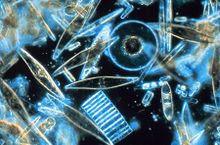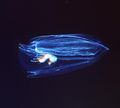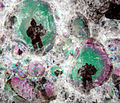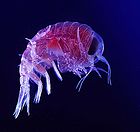- Plankton
-
For other uses, see Plankton (disambiguation).
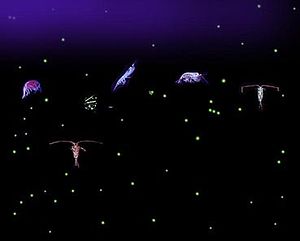 Photomontage of planktonic organisms
Photomontage of planktonic organisms
Plankton (singular plankter) are any drifting organisms (plants, archaea, or bacteria) that inhabit the pelagic zone of oceans, seas, or bodies of fresh water. That is, plankton are defined by their ecological niche rather than phylogenetic or taxonomic classification. They provide a crucial source of food to larger, more familiar aquatic organisms such as fish and whales.
Though many planktic (or planktonic—see section on Terminology) species are microscopic in size, plankton includes organisms covering a wide range of sizes, including large organisms such as jellyfish.
Contents
Terminology
The name plankton is derived from the Greek adjective πλαγκτός - planktos, meaning "errant", and by extension "wanderer" or "drifter".[1] Plankton typically flow with ocean currents. While some forms are capable of independent movement and can swim hundreds of meters vertically in a single day (a behavior called diel vertical migration), their horizontal position is primarily determined by the surrounding currents. This is in contrast to nekton organisms that can swim against the ambient flow and control their position (e.g. squid, fish, and marine mammals).
Within the plankton, holoplankton spend their entire life cycle as plankton (e.g. most algae, copepods, salps, and some jellyfish). By contrast, meroplankton are only planktic for part of their lives (usually the larval stage), and then graduate to either a nektic or benthic (sea floor) existence. Examples of meroplankton include the larvae of sea urchins, starfish, crustaceans, marine worms, and most fish.
Plankton abundance and distribution are strongly dependent on factors such as ambient nutrient concentrations, the physical state of the water column, and the abundance of other plankton.
The study of plankton is termed planktology and a planktonic individual is referred to as a plankter.[2]
The widespread use of planktonic in both scientific and popular literature is grammatically incorrect because of the Greek roots of plankton. When deriving English words from their Greek or Latin roots the gender specific ending (in this case "-on," which indicates the word is neuter) is dropped, using only the root of the word in the derivation. The less commonly used planktic is the correct adjective.[3]
Trophic groups
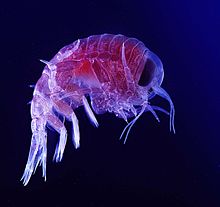 An amphipod (Hyperia macrocephala)
An amphipod (Hyperia macrocephala)
Plankton are primarily divided into broad functional (or trophic level) groups:
- Phytoplankton (from Greek phyton, or plant), autotrophic, prokaryotic or eukaryotic algae that live near the water surface where there is sufficient light to support photosynthesis. Among the more important groups are the diatoms, cyanobacteria, dinoflagellates and coccolithophores.
- Zooplankton (from Greek zoon, or animal), small protozoans or metazoans (e.g. crustaceans and other animals) that feed on other plankton and telonemia. Some of the eggs and larvae of larger animals, such as fish, crustaceans, and annelids, are included here.
- Bacterioplankton, bacteria and archaea, which play an important role in remineralising organic material down the water column (note that the prokaryotic phytoplankton are also bacterioplankton).
This scheme divides the plankton community into broad producer, consumer and recycler groups. However, determining the trophic level of some plankton is not straightforward. For example, although most dinoflagellates are either photosynthetic producers or heterotrophic consumers, many species are mixotrophic depending upon circumstances.
Size groups
Plankton are also often described in terms of size.[4] Usually the following divisions are used:
Group Size range (ESD) Megaplankton > 2×10−2 m (20+ mm) metazoans; e.g. jellyfish; ctenophores; salps and pyrosomes (pelagic Tunicata); Cephalopoda Macroplankton 2×10−3→2×10−2 m (2–20 mm) metazoans; e.g. Pteropods; Chaetognaths; Euphausiacea (krill); Medusae; ctenophores; salps, doliolids and pyrosomes (pelagic Tunicata); Cephalopoda Mesoplankton 2×10−4→2×10−3 m (0.2 mm-2 mm) metazoans; e.g. copepods; Medusae; Cladocera; Ostracoda; Chaetognaths; Pteropods; Tunicata; Heteropoda Microplankton 2×10−5→2×10−4 m (20-200 µm) large eukaryotic protists; most phytoplankton; Protozoa (Foraminifera); ciliates; Rotifera; juvenile metazoans - Crustacea (copepod nauplii) Nanoplankton 2×10−6→2×10−5 m (2-20 µm) small eukaryotic protists; Small Diatoms; Small Flagellates; Pyrrophyta; Chrysophyta; Chlorophyta; Xanthophyta Picoplankton 2×10−7→2×10−6 m (0.2-2 µm) small eukaryotic protists; bacteria; Chrysophyta Femtoplankton < 2×10−7 m (< 0.2 µm) marine viruses However, some of these terms may be used with very different boundaries, especially on the larger end of the scale. The existence and importance of nano- and even smaller plankton was only discovered during the 1980s, but they are thought to make up the largest proportion of all plankton in number and diversity.
The microplankton and smaller groups are microorganisms and operate at low Reynolds numbers, where the viscosity of water is much more important than its mass or inertia. [5]
Distribution
Plankton inhabit oceans, seas, lakes, ponds. Local abundance varies horizontally, vertically and seasonally. The primary cause of this variability is the availability of light. All plankton ecosystems are driven by the input of solar energy (but see chemosynthesis), confining primary production to surface waters, and to geographical regions and seasons having abundant light.
A secondary variable is nutrient availability. Although large areas of the tropical and sub-tropical oceans have abundant light, they experience relatively low primary production because they offer limited nutrients such as nitrate, phosphate and silicate. This results from large-scale ocean circulation and water column stratification. In such regions, primary production usually occurs at greater depth, although at a reduced level (because of reduced light).
Despite significant macronutrient concentrations, some ocean regions are unproductive (so-called HNLC regions).[6] The micronutrient iron is deficient in these regions, and adding it can lead to the formation of blooms of many kinds of phytoplankton.[7] Iron primarily reaches the ocean through the deposition of dust on the sea surface. Paradoxically, oceanic areas adjacent to unproductive, arid land thus typically have abundant phytoplankton (e.g., the eastern Atlantic Ocean, where trade winds bring dust from the Sahara Desert in north Africa). While plankton are most abundant in surface waters, they live throughout the water column. At depths where no primary production occurs, zooplankton and bacterioplankton instead consume organic material sinking from more productive surface waters above. This flux of sinking material, so-called marine snow, can be especially high following the termination of spring blooms.
Biogeochemical significance
Aside from representing the bottom few levels of a food chain that supports commercially important fisheries, plankton ecosystems play a role in the biogeochemical cycles of many important chemical elements, including the ocean's carbon cycle.
Primarily by grazing on phytoplankton, zooplankton provide carbon to the planktic foodweb, either respiring it to provide metabolic energy, or upon death as biomass or detritus. Typically more dense than seawater, organic material tends to sink. In open ocean ecosystems away from the coasts this transports carbon from surface waters to the deep. This process is known as the biological pump, and is one reason that oceans constitute the largest carbon sink on Earth.
It might be possible to increase the ocean's uptake of carbon dioxide generated through human activities by increasing plankton production through "seeding", primarily with the micronutrient iron. However, this technique may not be practical at a large scale. Ocean oxygen depletion and resultant methane production (caused by the excess production remineralising at depth) is one potential drawback.[8][9]
Biomass variability
The growth of phytoplankton populations is dependent on light levels and nutrient availability. The chief factor limiting growth varies from region to region in the world's oceans. On a broad scale, growth of phytoplankton in the oligotrophic tropical and subtropical gyres is generally limited by nutrient supply, while light often limits phytoplankton growth in subarctic gyres. Environmental variability at multiple scales influences the nutrient and light available for phytoplankton, and as these organisms form the base of the marine food web, this variability in phytoplankton growth influences higher trophic levels. For example, at interannual scales phytoplankton levels temporarily plummet during El Nino periods, influencing populations of zooplankton, fishes, sea birds, and marine mammals.
The effects of anthropogenic warming on the global population of phytoplankton is an area of active research. Changes in the vertical stratification of the water column, the rate of temperature-dependent biological reactions, and the atmospheric supply of nutrients are expected to have important impacts on future phytoplankton productivity.[10] Additionally, changes in the mortality of phytoplankton due to rates of zooplankton grazing may be significant.
Freshly hatched fish larvea are also plankton for a few days as long as they cannot swim against currents.
-
An amphipod photo of exoskeletoned animal with curved body, with two long and two short antenna.
-
A copepod (Calanoida sp.) from Antarctica ca. 12 mm long, photo of translucent ovoid animal with two long antennae
-
antarctic krill, the once largest biomass of the planet
-
Tomopteris is a genus of marine planktonic polychaete
Importance to fish
Zooplankton are the initial prey item for almost all fish larvae as they switch from their yolk sacs to external feeding. Fish rely on the density and distribution of zooplankton to match that of new larvae, which can otherwise starve. Natural factors (e.g., current variations) and man-made factors (e.g. river dams) can strongly affect zooplankton, which can in turn strongly affect larval survival, and therefore breeding success.
See also
- Aeroplankton
- Algal bloom
- Biological pump
- Gelatinous zooplankton
- Holoplankton
- Iron fertilization
- Meroplankton
- Nekton
- Ocean acidification
- Paradox of the plankton
- Phytoplankton
- Primary production
- Seston
- Zooplankton
References
- ^ Thurman, H. V. (1997). Introductory Oceanography. New Jersey, USA: Prentice Hall College. ISBN 0132620723.
- ^ Britannica.com
- ^ Emiliani, C. (1991). "Planktic/Planktonic, Nektic/Nektonic, Benthic/Benthonic". Journal of Paleontology (Journal of Paleontology, Vol. 65, No. 2) 65 (2): 329. JSTOR 1305769.
- ^ Omori, M.; Ikeda, T. (1992). Methods in Marine Zooplankton Ecology. Malabar, USA: Krieger Publishing Company. ISBN 0-89464-653-2.
- ^ Dusenbery, David B. (2009). Living at micro scale: the unexpected physics of being small. Cambridge: Harvard University Press. ISBN 0-674-03116-4.
- ^ Martin, J. H.; Fitzwater, S. E. (1988). "Iron-deficiency limits phytoplankton growth in the Northeast Pacific Subarctic". Nature 331 (6154): 341–343. doi:10.1038/331341a0.
- ^ Boyd, P.W., et al.; Watson, AJ; Law, CS; Abraham, ER; Trull, T; Murdoch, R; Bakker, DC; Bowie, AR et al. (2000). "A mesoscale phytoplankton bloom in the polar Southern Ocean stimulated by fertilization". Nature 407 (6805): 695–702. doi:10.1038/35037500. PMID 11048709.
- ^ Chisholm, S.W., et al.; Falkowski, PG; Cullen, JJ (2001). "Dis-crediting ocean fertilization". Science 294 (5541): 309–310. doi:10.1126/science.1065349. PMID 11598285.
- ^ Aumont, O.; Bopp, L. (2006). "Globalizing results from ocean in situ iron fertilization studies". Global Biogeochemical Cycles 20 (2): GB2017. Bibcode 2006GBioC..20.2017A. doi:10.1029/2005GB002591. http://www.agu.org/pubs/crossref/2006/2005GB002591.shtml.
- ^ Steinacher, M., et al. (2010), Projected 21st century decrease in marine productivity: a multi-model analysis, Biogeosciences, 7, 979-1005
Further reading
- Dusenbery, David B. (2009). Living at Micro Scale: The Unexpected Physics of Being Small. Harvard University Press, Cambridge, Mass. ISBN 978-0-674-03116-6.
- Kiørboe, Thomas (2008). A Mechanistic Approach to Plankton Ecology. Princeton University Press, Princeton, N.J. ISBN 978-0-691-13422-2.
- Kirby, Richard R. (2010). Ocean Drifters: A Secret World Beneath the Waves. Studio Cactus Ltd, UK. ISBN 978-1-904239-10-9.
External links
- Plankton Chronicles Short documentary films & photos
- COPEPOD: The global plankton database, global coverage database of zooplankton biomass and abundance data
- Plankton*Net, taxonomic database of images of plankton species
- Guide to the marine zooplankton of south eastern Australia, Tasmanian Aquaculture and Fisheries Institute
- Sir Alister Hardy Foundation for Ocean Science - Continuous Plankton Recorder Survey
- Australian Continuous Plankton Recorder Project, Integrated Marine Observing System
- Dr Richard Kirby (February 5, 2010). "Audio slideshow: Sea drifters". BBC News. http://news.bbc.co.uk/1/hi/sci/tech/8498786.stm.
- Plankton, planktic, planktonic Essays on nomenclature
Aquatic ecosystems – general and freshwater components General - Aquatic ecosystems
- Acoustic ecology
- Agent-based models
- Algal bloom
- Anoxic waters
- Aquatic adaptation
- Aquatic animals
- Aquatic biodiversity research
- Aquatic biomonitoring
- Aquatic insects
- Aquatic layers
- Aquatic mammals
- Aquatic plants
- Aquatic predation
- Aquatic respiration
- Aquatic science
- Aquatic toxicology
- Benthos
- Bioluminescence
- Biomass
- Cascade effect
- Colored dissolved organic matter
- Dead zone
- Ecohydrology
- Eutrophication
- Fisheries science
- Food chain
- Food web
- GIS and aquatic science
- Hydrobiology
- Hypoxia
- Isotope analysis
- Microbial ecology
- Microbial food web
- Microbial loop
- Nekton
- Neuston
- Particle
- Photic zone
- Phytoplankton
- Plankton
- Productivity
- Ramsar Convention
- Schooling
- Sediment trap
- Siltation
- Spawning
- Substrate
- Thermal pollution
- Trophic level
- Underwater camouflage and mimicry
- Water column
- Zooplankton
- More...

Freshwater - Freshwater ecosystems
- Brackish marsh
- Freshwater biology
- Freshwater biomes
- Freshwater fish
- Freshwater marsh
- Freshwater swamp forest
- Hyporheic zone
- Lake ecosystems
- Landscape limnology
- Limnology
- Lake stratification
- Macrophyte
- Pond
- Fish pond
- Rheotaxis
- River ecosystems
- Stream bed
- Stream pool
- Trophic state index
- Upland and lowland
- Water garden
- Wetland
- Environmental quality
- More...
Ecoregions - Freshwater ecoregions
- List of freshwater ecoregions
- Marine ecoregions
- List of marine ecoregions
- Ecology of the Everglades
- Ecology of the San Francisco Estuary
- Ecosystem of the North Pacific Subtropical Gyre
- Freshwater ecology of Maharashtra
Aquatic ecosystems – marine components Marine 
Marine
life forms- Census of Marine Life
- Coastal fish
- Coral reef fish
- Deep sea communities
- Deep sea creature
- Deep sea fish
- Deep water corals
- Demersal fish
- Marine bacteriophage
- Marine invertebrates
- Marine larval ecology
- Marine mammal
- Marine reptile
- Marine vertebrate
- Paradox of the plankton
- Pelagic fish
- Seabird
- Seashore wildlife
- Wild fisheries
Marine
habitats- Bay mud
- Black smokers
- Coastal biogeomorphology
- Cold seeps
- Coral reefs
- Davidson Seamount
- Estuaries
- Intertidal ecology
- Intertidal wetland
- Kelp forests
- Hydrothermal vent
- Lagoons
- Mangroves
- Marine biomes
- Marine habitats
- Mudflat
- Rocky shores
- Salt marshes
- Seagrass meadows
- Sponge reefs
- Tide pools
Issues - Ecological values of mangrove
- Fisheries and climate change
- HERMIONE
- Marine conservation
- Marine conservation activism
- Marine pollution
- Marine Protected Area
Categories:- Biological oceanography
- Planktology
- Aquatic ecology
Wikimedia Foundation. 2010.

